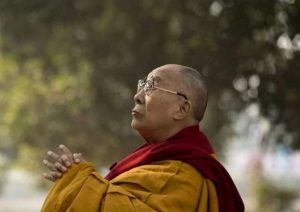In 1913, a young Pakistani farmer, Mohammad, stumbled on a remarkable discovery while digging up soil to build a new house. As he unearthed a stone face with distinctly Greek features, he had no idea that he had uncovered the ancient Greco-Buddhist temple complex of Jamal Gardi, located in a region that was once known as Gandhara.
Gazing into the divine eyes of what appeared to be a Greek god, Mohammad was astounded. After he excavated the statue, his father quickly capitalized on his son’s find by selling it to a British soldier. This statue, however, was unique—it featured the Buddha’s characteristic bubble-style hairdo, but with the typical wavy hair of Greek heroes. Today, this artifact is celebrated as one of the oldest Greco-Buddhist statues from the Kushan dynasty (30–375 CE), proudly displayed in London’s Victoria and Albert Museum.
The significance of this discovery is profound. Firstly, Gandhara statues represent the earliest known depictions of the Buddha in human form. Prior to this, Buddhist art was aniconic, symbolized not by anthropomorphic images but by objects. For 600 years after Siddhartha Gautama’s birth, his image had not been rendered in stone.

Secondly, the Buddha we recognize today was born a prince from the Indic Shakya lineage. Yet, the first Buddha statue discovered bears more resemblance to a Greek face than an Indic one. This raises intriguing questions about the Hellenistic influence on the region, and even that of Alexander the Great.
Looking at this mysterious Buddha statue, discovered 1,900 kilometers from the Buddha’s world in Lumbini and Bodh Gaya, I ponder on not only how Alexander the Great influenced Buddhism, but how did Buddhism influence Alexander the Great and Greece?
To delve deeper into the influence of Buddhism on Alexander, I sought out the wisdom of the director of the University of Hong Kong’s Centre of Buddhist Studies, Professor Georgios Halkias. During my interview with Prof. Halkias, who was also co-editor-in-chief of the Oxford Encyclopedia of Buddhism, I posed my question directly: “Is it plausible that Alexander the Great was influenced by the Buddhist teachings?”
With a mysterious smile, the Athens-born academic replied after a moment of contemplation, “An absence of material evidence is not evidence of absence.”
Our origins
Before Alexander’s arrival in Gandhara in 327 BCE, Buddhism had already been established for some 200 years, but in art was primarily expressed through symbols rather than the human form. The Buddha was portrayed via symbols indicating a traceless yet sublime absence, such as footprints, an empty throne, a pillar of fire, or a parasol. He was also depicted through the four mythic symbols of the Buddha’s life story: a lotus for his birth, the Bodhi tree for his enlightenment, a Dharma wheel symbolizing the first discourse, and a stupa representing his Parinirvana or death.
When Alexander invaded Central Asia and the Indian subcontinent, he brought with him an influx of Hellenistic influences. Greek artists and craftsmen introduced realistic representations of the human form, intricate drapery and the use of perspective in art and sculpture. This led to the development of Greco-Buddhist art, where the Buddha was first illustrated in human form, in stone and metal, in bas-relief, and on coins. This artistic transformation marked a significant shift in the history of Buddhist iconography.
The fusion of Greek and the Indo-Aryan local artistic traditions led to a cultural syncretism and the beginning of Greco-Buddhist art, evident in depiction of Buddhist themes using Greek artistic conventions. For example, the Buddha was often portrayed with Greco-Roman features, such as wavy hair, a serene expression, and draped robes.
The subsequent cultural and artistic exchange continued to flourish under Alexander’s successors. Following the examples of the kings of the Greek city-states, who were royal patrons of art, Indo-Greek kings continued to patronize and perpetuate the unique artistic characteristics in the region.
Alexander’s campaigns established overland trade routes through the Parthian Empire and Indo-Greek cities that predated Zhang Qian’s (d. c. 114 BCE) opening of silk routes from China by about 200 years. This facilitated the exchange of not only trade and materials, but art, culture, religion, and philosophy. Far from merely increasing the cosmopolitan nature of Gandhara, his trade routes were a catalyst for the spread of Buddhism to the West.
Furthermore, artistic representations of the Buddha and his life stories in the Indo-Greek style helped to make Buddhism more accessible and appealing to a broader audience, both Gandharan locals and Greek expatriates. After all, this vast population spoke multiple languages: Gandhari, Sanskrit, Greek, Old Persian, and numerous other dialects.
Art has the magical power to transcend language barriers, telling stories that resonate with the literate and illiterate alike. Through this universal language of colors and forms, art conveys emotions and narratives that everyone can grasp, fostering a sense of equality and shared destiny.
Lastly, since Alexander was accustomed to the polytheism of Greece and Egypt, could he have influenced a shift in popularity from a “philosophical-ascetic” emphasis (what the Greeks encountered when they were talking about the gymnosophists) to a more devotional bent of worshipping not just stupas, but actual images of the Buddha? I am careful not to repeat the Theravada-Mahayana dichotomy, but surely there was some kind of influence on the eventual rise of the Great Vehicle.
Either way, “the interaction between Greeks and Buddhists led to something beautiful that we know as Mahayana Buddhism,” confirms Prof. Halkias.

Intangible transmission through art and dance
Ancient Greek dance movement influences can still be heard echoing in the hearts of Ladakh’s monasteries, through the region’s famous cham dance today. Greek dances such as syrtos, sirtaki, and kalamatianos, where dancers hold hands and dance in a circle, could well be the root influence of a wedding celebration dance still practiced today in the Swat Valley, formerly known as Oddiyana, where Padmasambhava is possibly from.
Fellow BDG columnist Joseph Houseal, director of Core of Culture Dance Preservation (an organization committed to safeguarding intangible world heritage, with an emphasis on ancient dance and endangered movement traditions), shared with BDG Senior Writer Raymond Lam and myself that there is a dance in Pakistan called the “Attan” that was once prevalent in the Swat Valley. It is still practiced in many versions of Pakistani dance today. It is notably a circular dance that makes spiral turns in both directions. Houseal says that it is just like cham, but often much wilder, in a state of true, sometimes induced, trance.
The rubab, a lute-like instrument from Swat, echoes the Greek pandura and shares its melodic soul with the dranyen, the Tibetan lute. The rhythmic beats of the daf, reminiscent of the Greek tympanon, find their counterpart in the damaru, a small two-headed drum central to Himalayan rituals and dances. Traditional flutes such as the bansuri, akin to the Greek aulos, mirror the sweet notes of the lingbu, the Tibetan bamboo flute. These instruments weave a rich tapestry of shared musical heritage, highlighting the enduring connections between these distant yet intertwined regions.

How did Buddhism influence Alexander the Great and Greece?
After conquering territories across the Mediterranean and the Middle East, from Macedonia and Greece to Egypt and Persia, Alexander had travelled 4,400 kilometers by the time he had arrived in Taxila (modern-day Pakistan). Taxila was an ancient center of philosophy and religious studies: the ancient learning center (or university) of Taksashila Visvavidyalaya was established as early as 700 BCE.
Taksashila Visvavidyalaya attracted prominent astrologers, philosophers, medical doctors, lawmakers, ascetics, and military strategists. This academy predated Plato’s famous academy by 300 years, often considered the world’s first center of philosophy, founded in 387 BCE in Athens. Alexander might have felt a sense of familiarity with this place, akin to being back in Athens, where his teacher Aristotle instilled in the young conqueror-to-be a lifelong love of learning and curiosity about the world.
In our interview, Prof. Halkias, who hails from Rhodes, Greece, shared that Alexander was not only surrounded by early Buddhist practitioners, but was also deeply impressed by the Indian sages known as gymnosophists—a term used by the Greeks to refer to naked philosophers or ascetics. One particular sage adopted the Greek name Kalanos ir Calanus, and is the core subject of Halkias’s research.
Instead of fighting the invading Alexander, the ruler of Taxila, King Ambhi, allied with him and his 5,000 troops to conquer neighboring kingdoms. In a gesture of allegiance, Ambhi introduced Kalanos, who was a highly revered gymnosophist in his court, to Alexander. Alexander was so taken by Kalanos that he made him his teacher and companion for the remaining two years of his life, and brought him back to Susa in modern-day Iran, one of the most important cities of Alexander’s conquests.
As Alexander’s teacher, Kalanos had a notable influence on him during his campaign in India. “Known for his wisdom and ascetic lifestyle, Kalanos’ philosophical insights likely exposed Alexander to early Buddhist thought and practices,” says Halkias.
Incidentally, this wasn’t the first time the naked philosophers had left a lasting impression, as hundreds of years prior, one Prince Siddhartha had a retinue of Taxila gymnosophists who heavily influenced the evolution of his philosophy and the initial spread of his new order. Important figures in his inner circle, who had studied at Taksashila Visvavidyalaya, included Jivaka, his personal doctor.
Kalanos eventually became ill, according to historical accounts, and chose to end his life in Susa through self-immolation, entering a pyre in front of an awed Alexander and his army. This act of self-immolation, according to Halkias, is performed before a Buddhist practitioner’s mind succumbs to illness so that they can maintain clarity of mind at death (mainly to enter the jhanas). The year was 322 BCE, coincidentally the same year Alexander died in Babylon.

Pyrrho of Elis: founder of Pyrrhonism
While Kalanos influenced Alexander personally, the individual who brought Buddhist thought to Greece was Pyrrho of Elis (c. 360–270 BCE), says Halkias. Once a young poet who followed Alexander to India, Pyrrho studied with the gymnosophists and founded his own philosophical school called Pyrrhonism, an early form of skepticism.
His philosophy emphasized doubt and uncertainty, advocating for a suspension of judgment (epoché) on all beliefs and opinions. According to Pyrrho, by suspending judgment and refraining from making definite assertions, one can achieve mental tranquility (ataraxia). This approach suggests that since humans cannot attain certain knowledge, the wisest course of action is to withhold belief and remain open to multiple perspectives.
These concepts resemble the Buddhist ideas of non-attachment and non-duality. Buddhist philosophy also avoids metaphysical speculation: the Buddha spoke about how he addresses only suffering and how to transcend it, and used the simile of the poisoned arrow to criticize students obsessed with unanswerable questions like the origins of the universe.
Pyrrhonism profoundly influenced later philosophical traditions, particularly ancient skepticism and the works of philosophers such as Sextus Empiricus, who referred to Pyrrho as “a man of windless calm,” as Halkias says.

I am so intrigued by the cross-pollination of Greek and Indic cultures, that I can’t help but speculate. Could Alexander’s visage actually have been the original model for the first Gandhara statues? He certainly thought he was a god, claiming divine birth. He was infamous for what we would today call cosplay or live-action roleplaying, assuming the identities and characteristics of various deities in his conquered regions. He had a deliberate playbook to boost his legitimacy and legacy by association with divine power. After his death he was often worshipped as a god, with temples built in his honor. Even today in Central Asia there are tribes that claim descent from Alexander, and sing epics that contain distant memories of his conquests.
Alexander’s megalomania was often on full display. He named more than 70 cities Alexandria. There are stone carvings in which he was represented as the protector Vajrapani. This is the period when more bodhisattvas appear, lending form to the early Mahayana. I imagine it would have been unthinkable for him to choose any other image than himself as the almighty Buddha. What we know for certainty is that the melding of Greek and Buddhist traditions have deeply enriched both civilizations and left a lasting legacy, in music, art, philosophy, and culture. It is an area of research in which I eagerly anticipate more discoveries.
Related features from BDG
Isadora Duncan, Prajwal Vajracharya, and the Dancers of Huai-nan
Buddhism’s Retreat from India: A History Lesson in the Survival and Decline of the Dharma
Related blog posts from BDG Tea House
The Shakya Sage and the Son of Ra
Pyrrho: Greek hints of the Buddha’s Awakening
Menander: A Basileus and Maharaja in the Milindapanha
















Awesome article! I am almost overwhelmed by the amount of research and fact-checking that must have gone into producing such a high-quality article. I would never have associated Alexander with anything Buddhist, but here we are. Bravo!